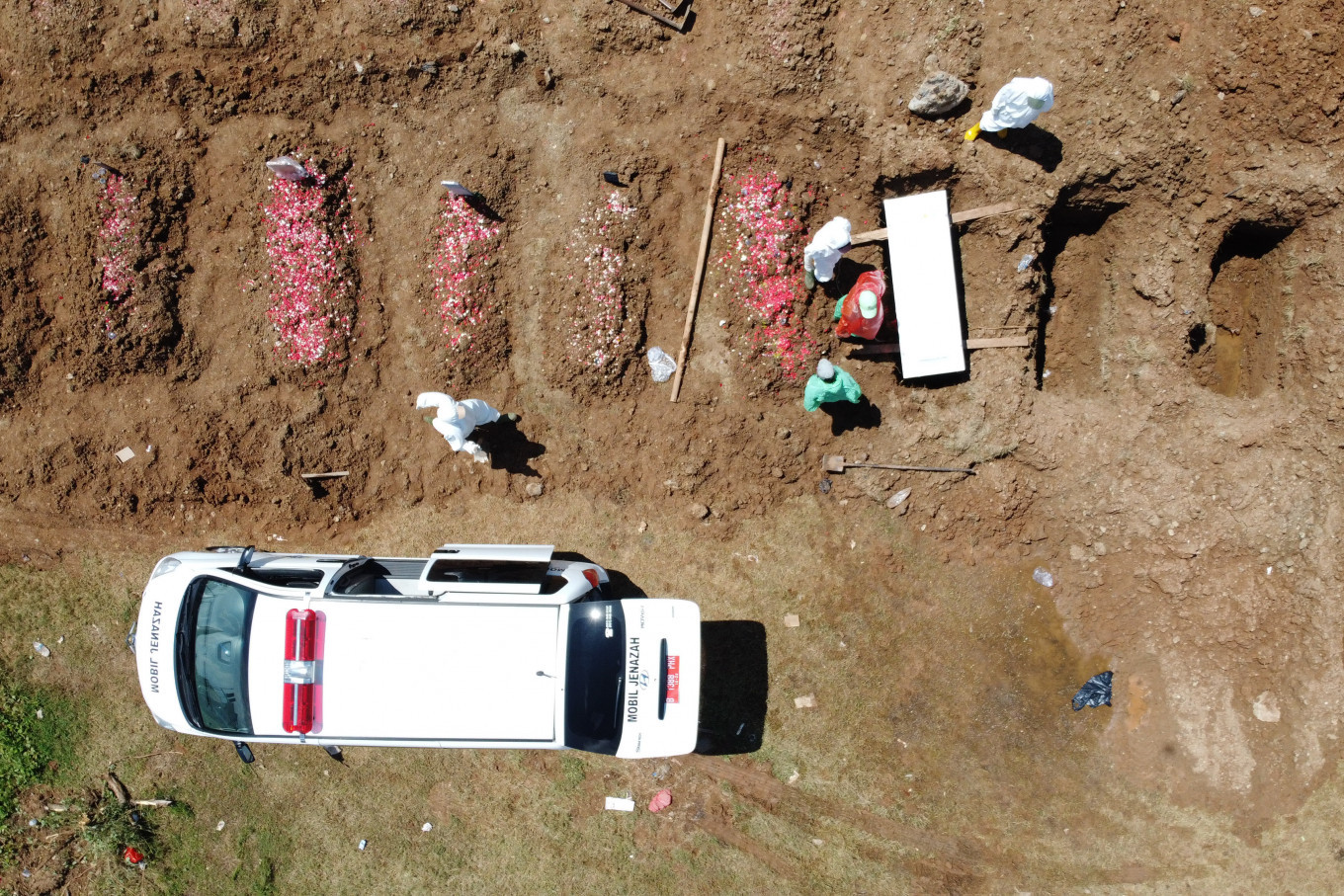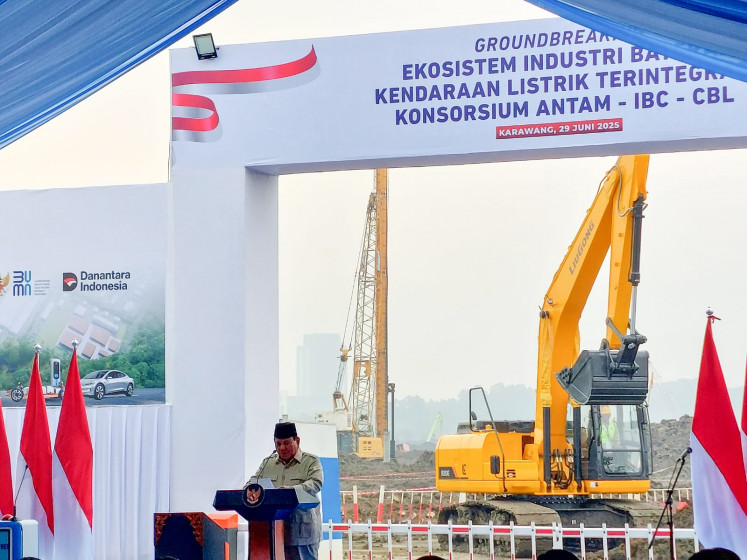Popular Reads
Top Results
Can't find what you're looking for?
View all search resultsPopular Reads
Top Results
Can't find what you're looking for?
View all search resultsAn examination of Indonesia's death toll: Could it be higher?
Change text size
Gift Premium Articles
to Anyone
 Jakarta Parks and Forestry Agency officials bury the bodies of several people who had died of coronavirus at Tegal Alur Public Cemetery, West Jakarta, on April 7. (JP/Donny Fernando)
Jakarta Parks and Forestry Agency officials bury the bodies of several people who had died of coronavirus at Tegal Alur Public Cemetery, West Jakarta, on April 7. (JP/Donny Fernando)
T
he actual number of COVID-19 deaths in Indonesia may be substantially higher than officially reported as several regions have recorded hundreds of fatalities among patients under surveillance (PDPs), who are suspected of having contracted the highly contagious coronavirus.
Patients under surveillance refer to people with COVID-19 symptoms who have not been confirmed as having the disease, meaning that they are waiting either to be tested or for their test results to come back.
The central government's daily count of fatalities, at 773 as of Tuesday, does not include all PDPs who have died. And it was only recently that the government started announcing the number of PDPs and people under observation (ODPs) nationwide. Previously, only local administrations would reveal such figures.
Some of these administrations have even gone a step further by revealing the number of fatalities among suspected patients.
Banten, a neighboring province to Jakarta, revealed on its website that as of Tuesday 144 of its 1,382 PDPs had died. East Java also reported 235 fatalities among its 2,769 PDPs and 53 among its 18,509 ODPs. These figures are higher than both regions' number of fatalities among confirmed cases, which reached 41 and 90 deaths, respectively, as of Tuesday.
Jakarta does not provide such data but has disclosed on its website that 1,666 people had been buried according to COVID-19 protocols as of April 24. The figure is higher than the city's official death toll of 370 as of Tuesday.
Central Java, meanwhile, does not provide the exact number but rather a map of the spread of such fatalities, which according to The Jakarta Post's estimation could amount to around 200, while its official death toll is 58. Yogyakarta recorded seven fatalities among its suspected patients, while its official count is seven. South Sulawesi reported 81 of its suspected patients had died despite recording only 37 official deaths, although it has published a disclaimer that the former figure also includes those who later test negative.
"ODPs and PDPs who died might have tested positive for COVID-19," biostatistics researcher at the University of Indonesia's (UI) School of Public Health, Iwan Ariawan, said. "Therefore, it is important [for authorities] to disclose how many of the ODPs and PDPs who died had been tested and later turned out to be positive, not only COVID-19 patients who have died."
In its latest weekly situation report on Indonesia, the World Health Organization said that as of April 11, it had updated the guidance for reporting COVID-19 deaths, in which a COVID-19 death was defined as a death resulting from a clinically compatible illness in a probable or confirmed COVID-19 case, unless there was a clear alternative cause of death that could not be related to COVID-19.
"Based on this definition, cumulative deaths from people who had or may have had COVID-19 should be reported as COVID-19 related deaths," the report said.
The government's spokesperson for COVID-19 affairs, Achmad Yurianto, said he was not aware of such a guideline. He said the tally of deaths he was announcing daily only included people who had tested positive for the virus, which was reported by hospitals. He said that even if Indonesia was to announce fatalities among suspected patients, the figures would be separated from those of confirmed cases.
Other countries have begun to revise their death toll linked to COVID-19. New York, the hardest-hit city in the United States, for instance, revised in mid-April its official COVID-19 death toll to include victims presumed to have died from lung diseases but never tested, resulting in a 60 percent spike, Reuters reported.
China also revised its death toll by adding some 1,290 deaths in Wuhan, the city where the virus first emerged in December, Bloomberg said, citing Chinese state media reports.
The late reporting of deaths was attributed to several reasons, including the fact that some patients had died at home without seeking treatment or being tested for the virus and the late and incomplete reporting by medical workers and institutions overwhelmed by the outbreak.
"It would be better if fatalities among ODPs and PDPs [in Indonesia] were also announced. However, I don’t think 100 percent of the fatalities would certainly be due to COVID-19," epidemiologist at Padjadjaran University, Panji Hadisoemarto said, warning of overestimation.
Read also: Govt claims Jakarta, epicenter of Indonesia's COVID-19 outbreak, has flattened the curve
So far 9,511 of 62,544 people who have been tested in Indonesia have been confirmed to have the virus, a positive testing rate of 15.2 percent as of Tuesday.
Persahabatan Central General Hospital, a referral hospital for COVID-19 patients in Jakarta, said 65 percent of PDPs it was treating had tested positive. While the Eijkman Institute for Molecular Biology said between 20 and 30 percent of the specimens it processed daily came back positive.
Nevertheless, experts agree that fatalities among suspected patients paint the possibility of Indonesia recording a higher number of deaths than it is currently reporting because of the lack of testing and a testing backlog. This remains a problem in the country, despite calls from President Joko "Jokowi" Widodo to boost testing capacity to 10,000 tests per day.
"Local administrations need to statistically verify the PDP fatalities into groups: how many had not been tested, were waiting for their results and were tested positive or negative,” said Iqbal Ridzi Fahdri Elyazar, disease surveillance and biostatistics researcher at the Eijkman-Oxford Clinical Research Unit. “They need to provide this public information because it's important for assessing the severity of the disaster and evaluating their control measures.”
Iwan of the UI, meanwhile, said the government would need data on suspected patients' deaths to evaluate how it had been handling suspected patients.
Read also: COVID-19: Indonesia claims daily testing capacity increase to 12,000
Indonesian Medical Association (IDI) spokesperson Halik Malik said such data would help hospitals evaluate their services and also act as a warning for the public not to undermine the scale of the COVID-19 outbreak to avoid complacency.
"Because of late testing results, the IDI is recommending the need for a new policy in handling patients under surveillance,” Halik said. “There's no need to wait for [polymerase chain reaction] PCR test results; [hospitals] can treat the patients as COVID-19 patients with clinical criteria [...] Otherwise, there'll be many whose conditions will deteriorate while waiting for their test results and not receiving treatment as COVID-19 patients.”
Persahabatan Hospital spokesperson Erlina Burhan told the Post on Monday that the hospital was treating PDPs according to COVID-19 protocols until proven otherwise. She acknowledged, however, in an online discussion on April 17, that the testing backlog was a problem.
"We should be receiving results in two days, but in reality [...] we sometimes receive them in five to seven days. This is making things quite difficult, especially when the patients are in a severe condition," Erlina said, adding that around 10 percent of the hospital's COVID-19 patients needed intensive care and ventilators.
Wiku Adisasmito, an expert with Indonesia's COVID-19 task force, said in an April 22 online press briefing to address international media, that limitations in early detection, coupled with tardy diagnostics, had led to the country's high mortality rate, but he gave an assurance that the government had been improving the country's laboratory capacity.
"Improvements in the quality of data also need to be made, so that mortality rate data can become more reliable," he said.
-- Fiqih Prawira Adjie contributed to this story









